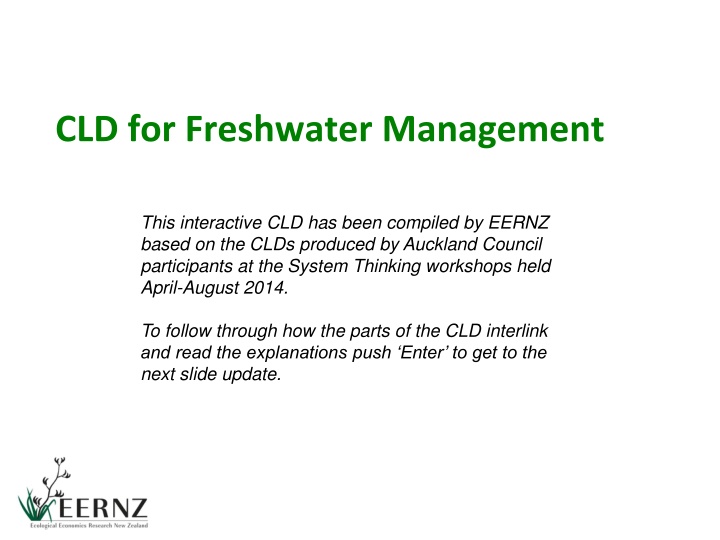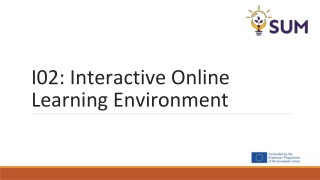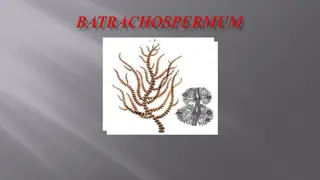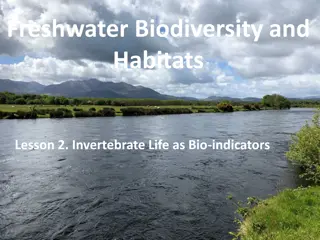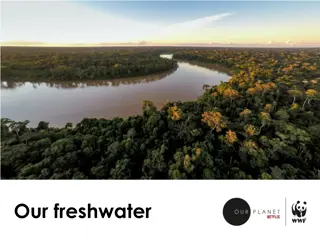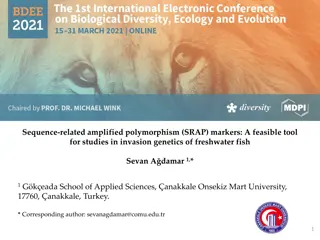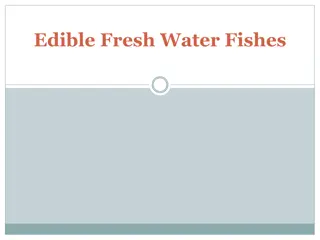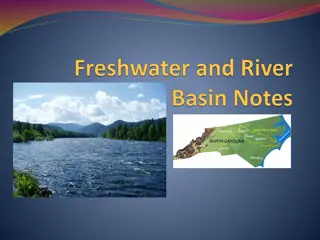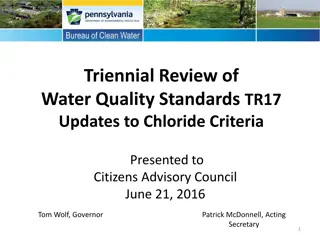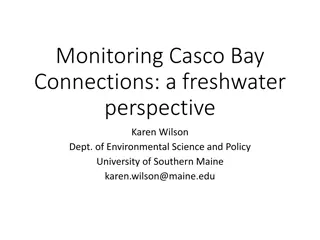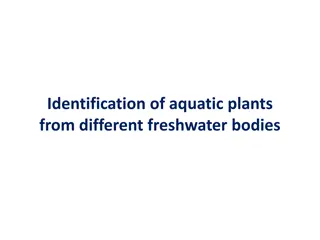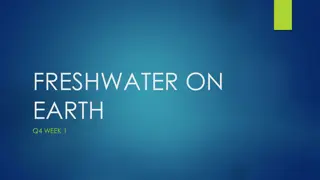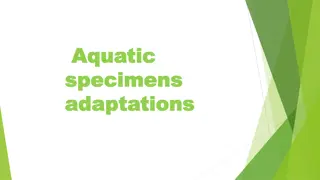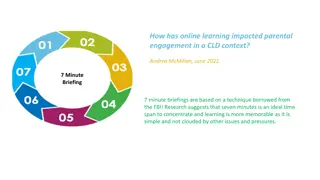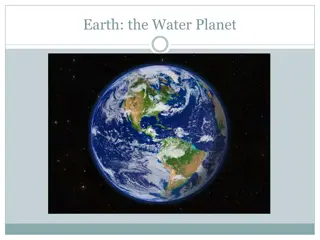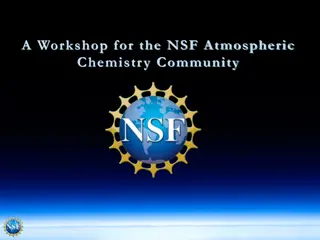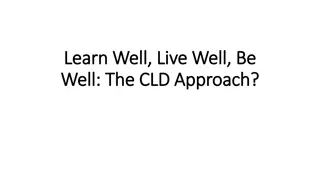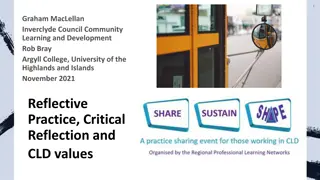Interactive CLD for Freshwater Management
This interactive CLD explores the state of freshwater, pressures to improve water quality, national objectives, community and iwi freshwater goals, regulatory activities, and the impact of development and population growth. The interlinking parts of the CLD illustrate the complex dynamics involved in managing freshwater resources effectively.
Download Presentation

Please find below an Image/Link to download the presentation.
The content on the website is provided AS IS for your information and personal use only. It may not be sold, licensed, or shared on other websites without obtaining consent from the author.If you encounter any issues during the download, it is possible that the publisher has removed the file from their server.
You are allowed to download the files provided on this website for personal or commercial use, subject to the condition that they are used lawfully. All files are the property of their respective owners.
The content on the website is provided AS IS for your information and personal use only. It may not be sold, licensed, or shared on other websites without obtaining consent from the author.
E N D
Presentation Transcript
CLD for Freshwater Management This interactive CLD has been compiled by EERNZ based on the CLDs produced by Auckland Council participants at the System Thinking workshops held April-August 2014. To follow through how the parts of the CLD interlink and read the explanations push Enter to get to the next slide update.
A STORY OF THE STATE OF FRESHWATER AND CONSIDERING A SCALE FOR FMUs FOR LIMIT SETTING + Pressure to improve water + + National Policy Goal of Improved Freshwater Population + B1 National Policy Goal of Growth R4 + + + Iwi Freshwater Objectives gap National Objectives for Freshwater Development + Iwi Freshwater Objectives B2 - B3 + + Iwi mana + + Cultural capital Community Freshwater Objectives gap + - Regional Council Regulation of Water Activities (e.g. water takes, discharge consents, limits) - Freshwater state + + - Flexibility to achieve limits Non-regulatory action B10 + + Accounting costs Community freshwater objectives - + + + + Number of people engaged Data required to set limits Engagement cost R9 + - B6 + Implementation costs per FMU + B5 Engagement scale/type + Desire to change number of FMUs + + Policy development costs Data gap + Understanding of wider context + - - Data available (monitoring and modelling) + Number of FMUs B7 - B8 + Maintenance costs of monitoring # monitoring sites and costs +
This results in the National Objectives for Freshwater + Pressure to improve water Pressure to improve freshwater increases when the community objectives are not met.. + National Objectives for Freshwater B1 B1: Over time this improves the state of freshwater and reduces the gap. Council response to pressure + + Community Freshwater Objectives gap + Regional Council Regulation of Water Activities (e.g. water takes, discharge consents, limits) - Freshwater state + Regulation of water activities by regional councils follows National Objectives If the state of freshwater is worse/better than communities would like there is a gap.
+ Pressure to improve water B2: State of freshwater creates a gap with iwi aspirations, through cultural objectives, leading to pressure to improve freshwater. + + National Objectives for Freshwater B1 Iwi Freshwater Objectives gap + + B2 Iwi Freshwater Objectives - + Iwi mana + Cultural capital Community Freshwater Objectives gap + - Regional Council Regulation of Water Activities (e.g. water takes, discharge consents, limits) - Freshwater state +
R4: Development and population reinforce upward or downward depending on dominance of driver + Pressure to improve water + + National Objectives for Freshwater B1 Population + National Policy Goal of Growth R4 + Iwi Freshwater Objectives gap + Development + National Policy Goal of Growth is a driver outside this system competing with signals within this system - Iwi Freshwater Objectives + B2 - B3 + = Iwi mana + Cultural capital Community Freshwater Objectives gap + + Regional Council Regulation of Water Activities (e.g. water takes, discharge consents, limits) + - Freshwater state + B3: Development is limited by freshwater state. After a time lag Regional Council regulation improves the state of freshwater which allows more development.
FMU Scale Engagement increases associated costs. [Note there may be scope to engage more efficiently and lower costs.] Engagement costs changes desire to change the number of FMUs. Opportunity for engagement increases the number of people in setting community freshwater objectives. + Number of people engaged Engagement cost + + B5 Engagement level/type Desire to change number of FMUs + - Number of FMUs Assumption: an increase in the number of FMUs undertaken by AC increases the engagement requirements (scale/type) B5: Pressure to reduce the number of FMUs.
B6: Proposed higher community freshwater objectives will galvanise more dissatisfied people to become engaged.. Decreased understanding of the wider context (the impacts of high uniform standards on jobs, housing, farming etc.) will lead to increased (higher) localised community freshwater objectives. Community freshwater objectives - + + Number of people engaged Engagement cost + + B6 + B5 Engagement level/type Desire to change number of FMUs + Understanding of wider context - - Number of FMUs An increased number of FMUs with people only considering their localised situation will decrease understanding of the wider context.
Accounting costs Community freshwater objectives - + + + + Number of people engaged Engagement cost B7 + - + Implementation costs per FMU B5 B6 + Engagement scale/type + Desire to change number of FMUs + Policy development costs + Understanding of wider context - - Number of FMUs B7: An increased number of FMUs increase policy development costs, increase implementation costs per FMU and accounting costs. Leading to a desire to change the number of FMUs . This reinforces engagement cost .
Accounting costs Community freshwater objectives - + + + Number of people engaged Engagement cost B7 + + Implementation costs per FMU B6 + B5 Engagement scale/type + Desire to change number of FMUs + Policy development costs + Understanding of wider context - - Number of FMUs - + B8 Monitoring sites required Maintenance costs of monitoring + B8: An increased number of FMUs increases the number of monitoring sites required. Higher maintenance and monitoring costs will bring pressure for lower number of FMUs. Again cost driven!
Regulation increases the data required to set limits regardless of FMUs. With a time lag, regulation may reduce flexibility to achieve limits Regional Council Regulation of Water Activities (e.g. water takes, discharge consents, limits) = B10: If the FMUs increase there is more flexibility to achieve limits . This also reduces the desire to change the number of FMUs - Flexibility to achieve limits - Accounting costs B10 Community freshwater objectives - + + + + Number of people engaged Engagement cost B7 + + - Data required to set limits B6 + Implementation costs per FMU + B5 Engagement scale/type + Desire to change number of FMUs + + Policy development costs Data gap Understanding of wider context - + - - Data available (monitoring and modelling) + Number of FMUs + R9 - + B8 Monitoring sites required Maintenance costs of monitoring + R9: More monitoring sites provide more data , which reduces the data gap and allows for a higher number of FMUs as there is more localised spatially distributed data available.
THE END! + Pressure to improve water + + National Policy Goal of Improved Freshwater Population + B1 National Policy Goal of Growth R4 + + + Iwi Freshwater Objectives gap National Objectives for Freshwater Development + Iwi Freshwater Objectives B2 - B3 + + Iwi mana + Cultural capital Community Freshwater Objectives gap - + Regional Council Regulation of Water Activities (e.g. water takes, discharge consents, limits) - Freshwater state + + + More people engaged increase the scope for non-regulatory action. This will improve freshwater and reduce the gap. - Flexibility to achieve limits Non-regulatory action B10 + + Accounting costs Community freshwater objectives - + + + + Number of people engaged Data required to set limits Engagement cost B7 + - B6 + Implementation costs per FMU + B5 Engagement scale/type + Desire to change number of FMUs + + Policy development costs Data gap - Understanding of wider context + - - Data available (monitoring and modelling) + Number of FMUs B8 - B9 + Maintenance costs of monitoring # monitoring sites and costs +
